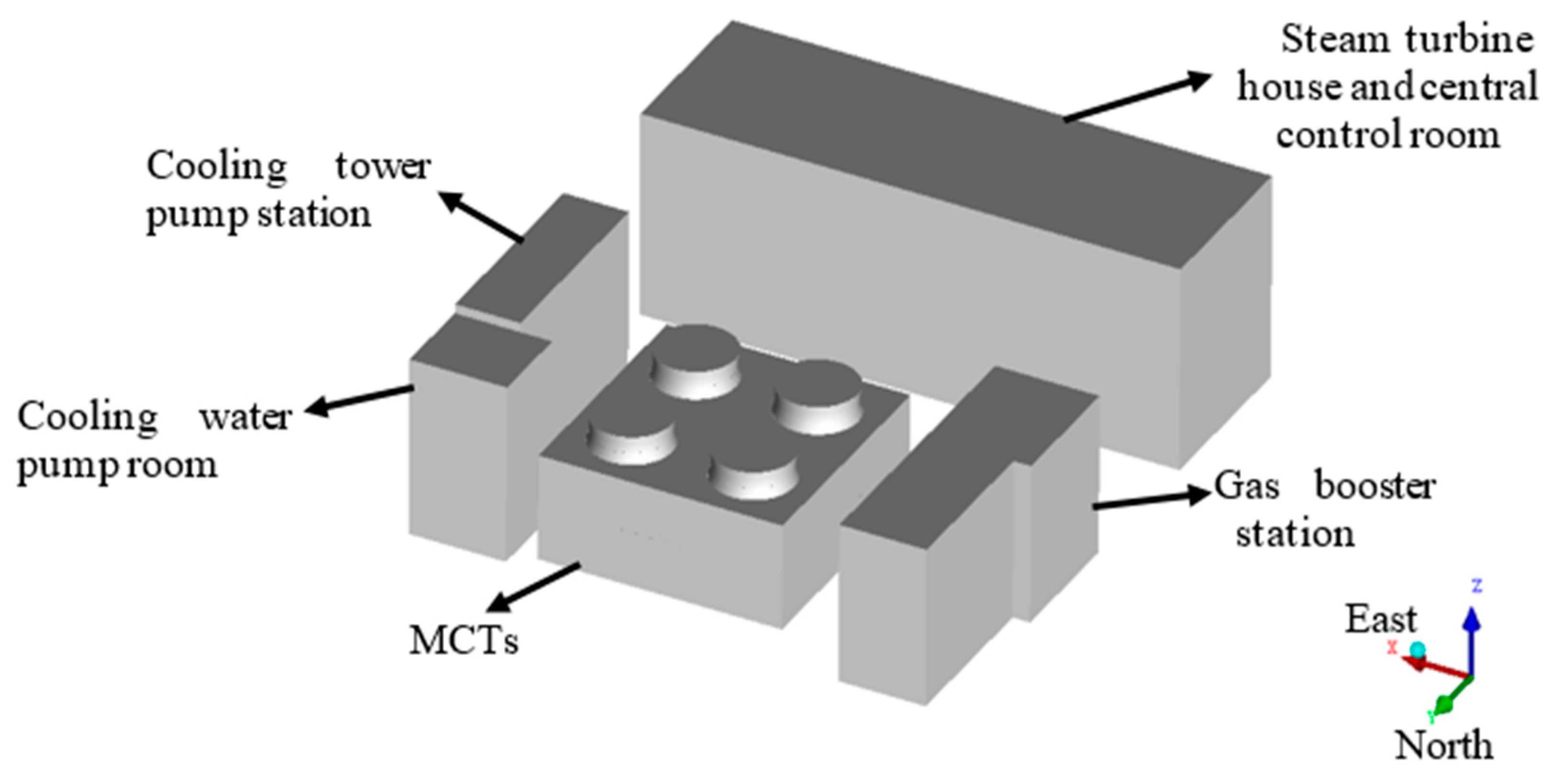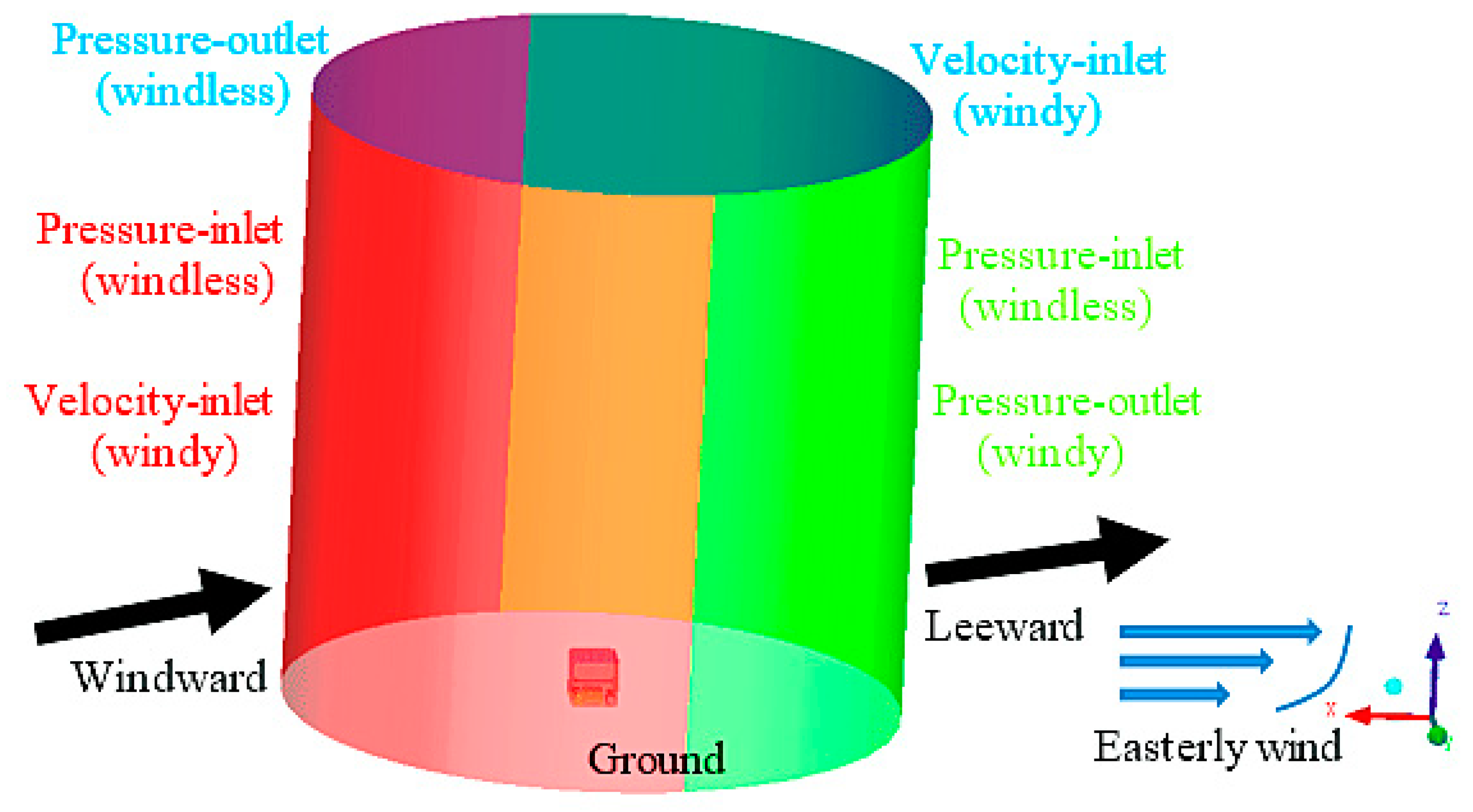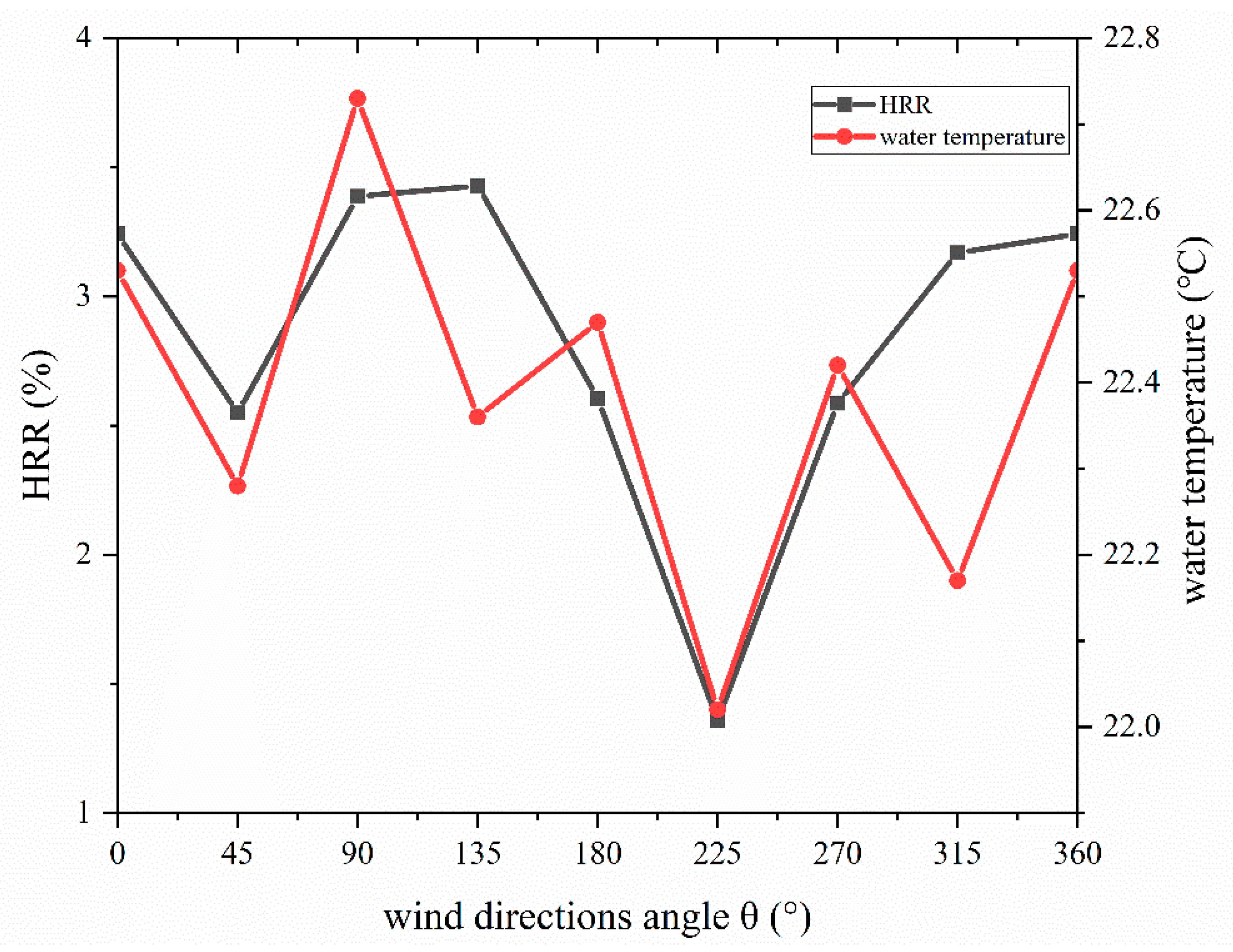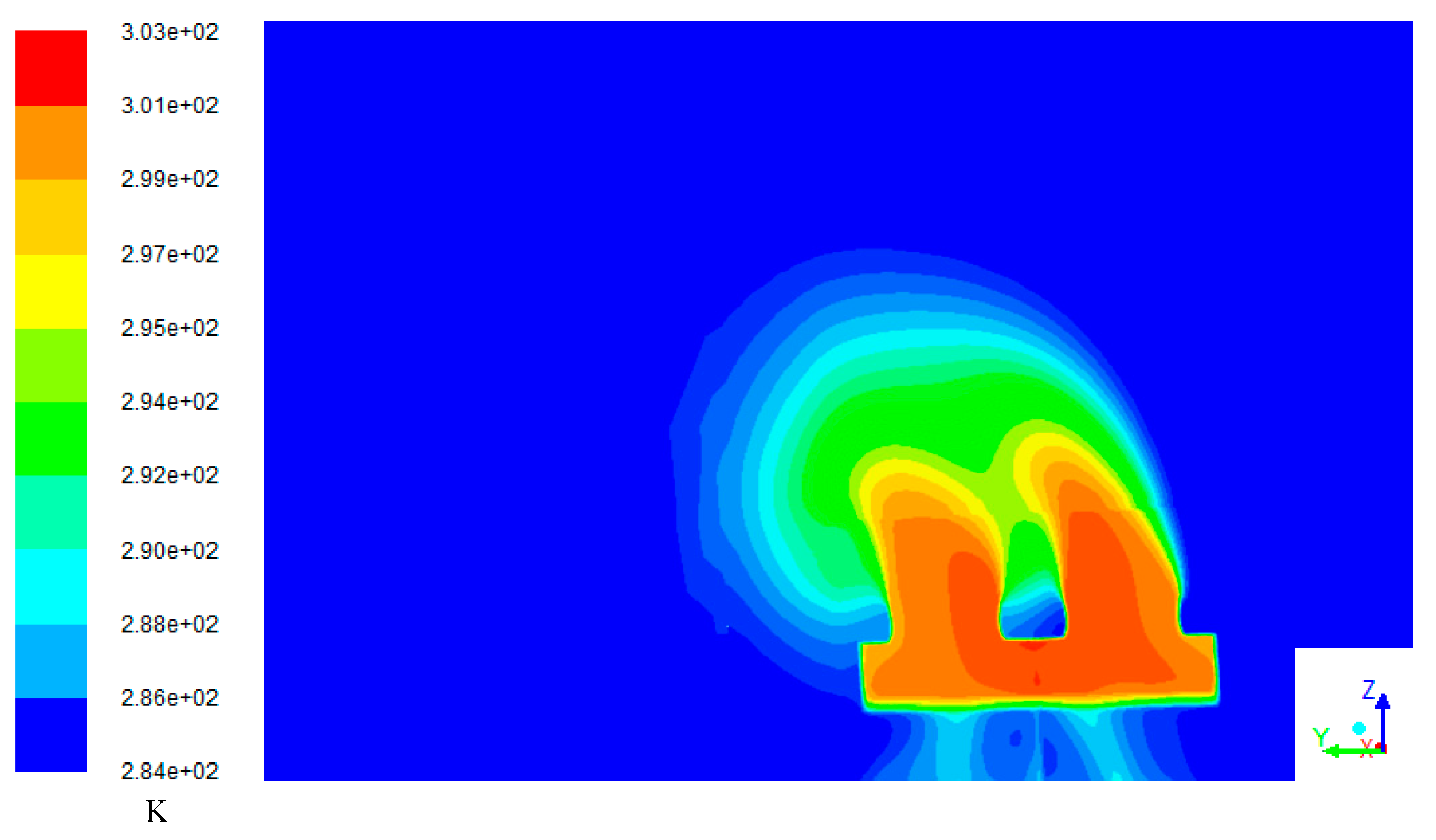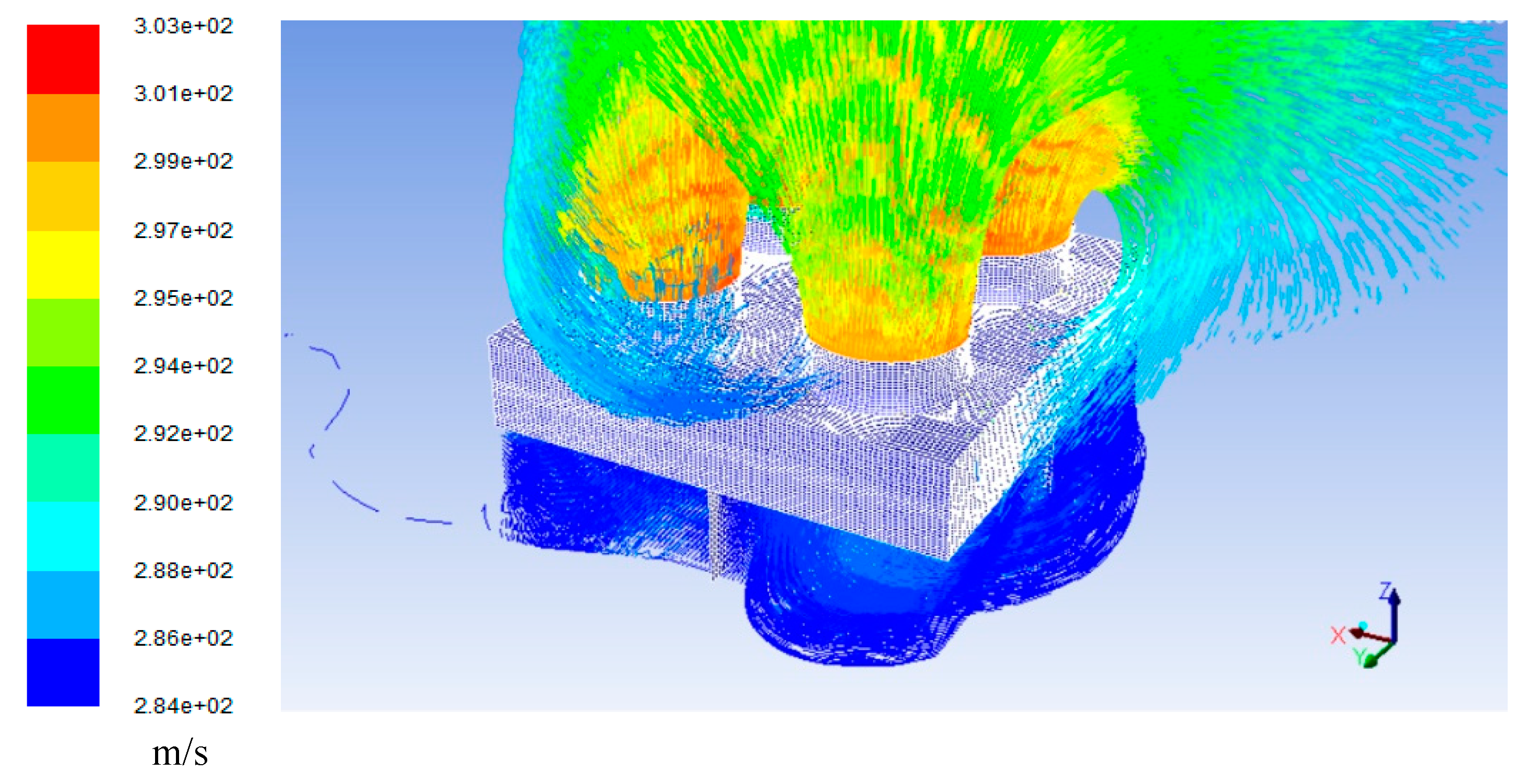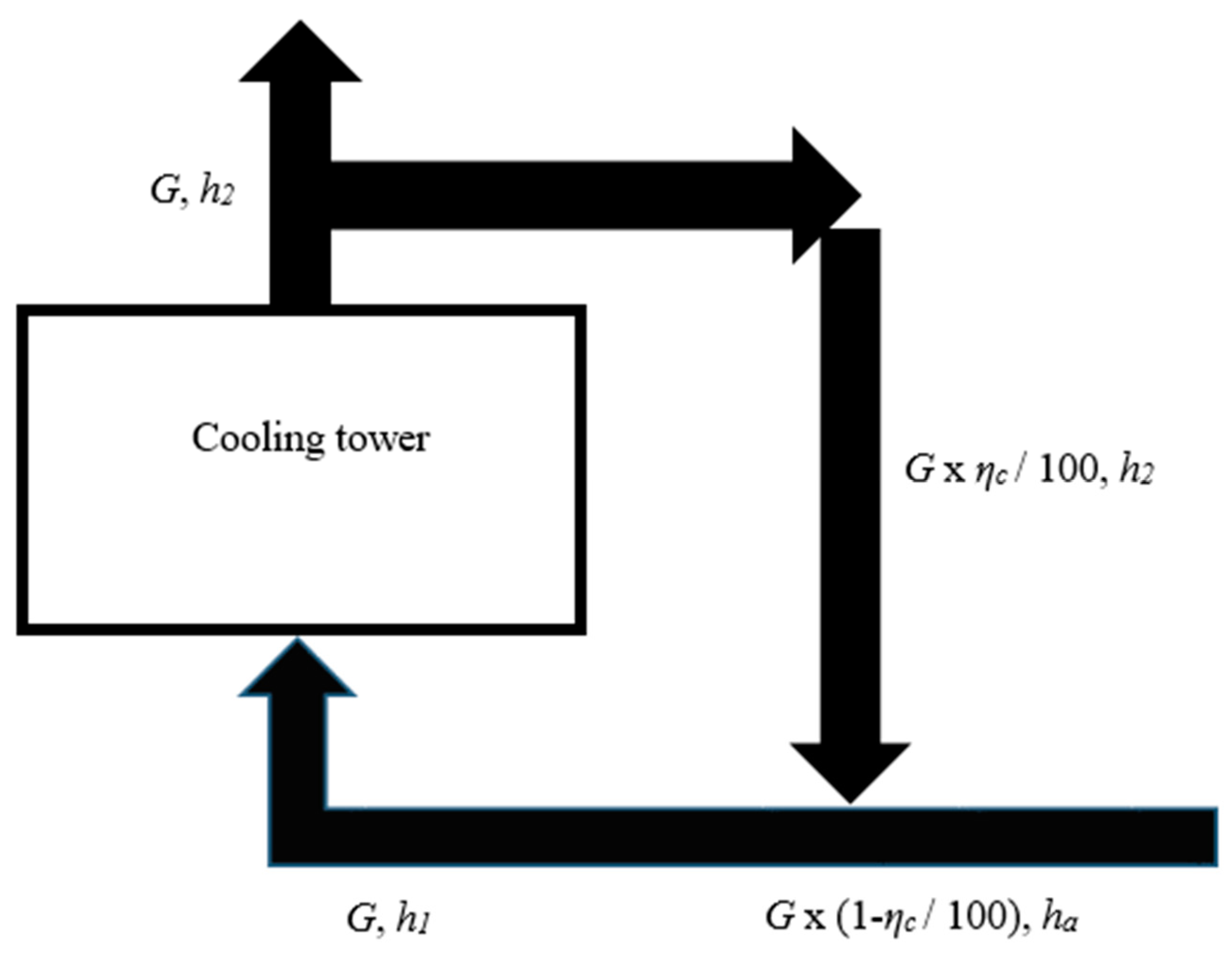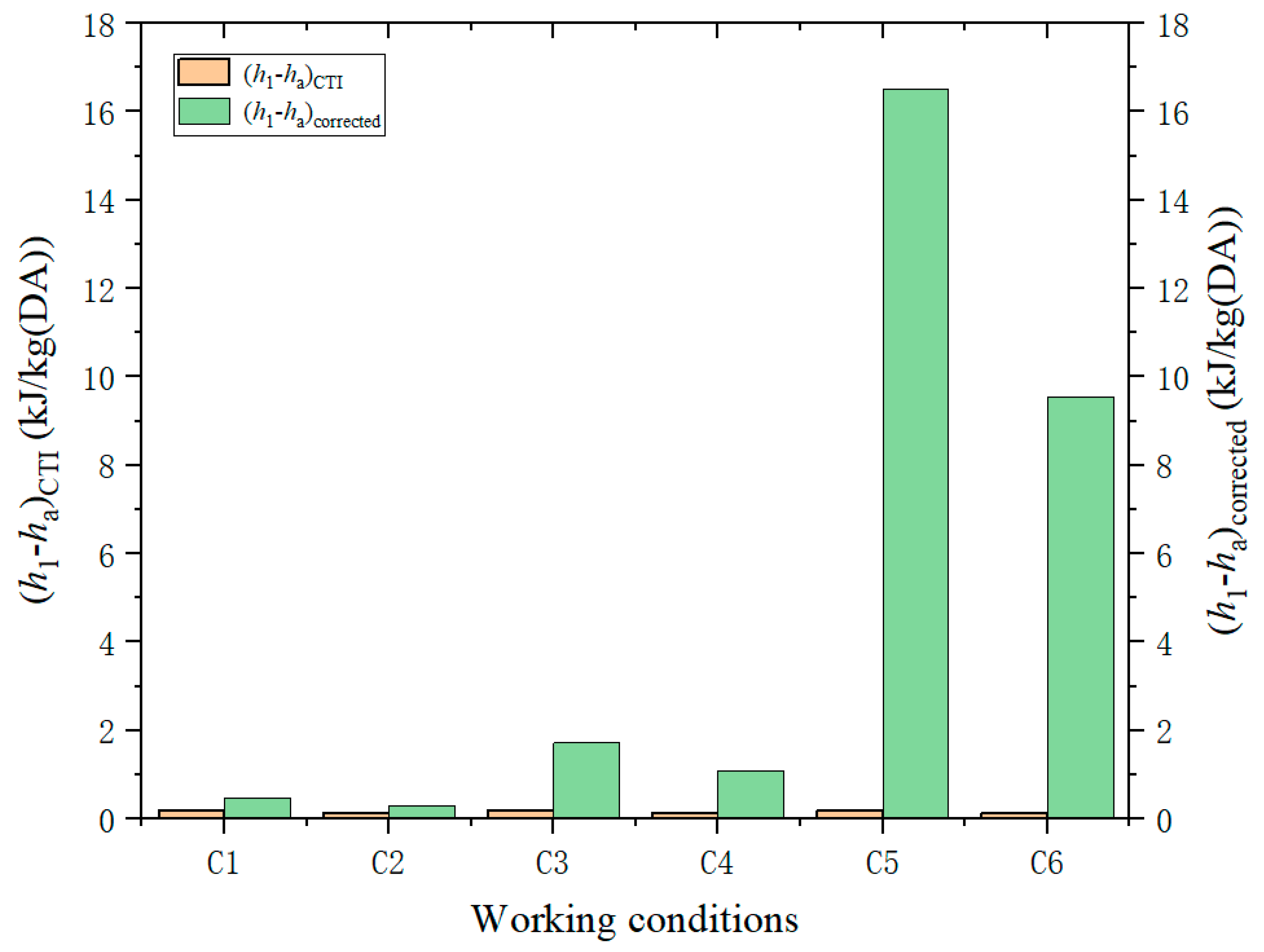1. Introduction
The cooling tower is a commonly used heat rejection device for thermal power plants [
1,
2,
3]. According to the way the air passes through the cooling towers, they can be divided into natural draft and mechanical draft cooling towers (MCTs). The MCTs draw air into the inlet of the towers through fans and exchange heat with high-temperature liquids to achieve the purpose of heat exchange. MCTs are widely used as one of the most economical, efficient, and energy-efficient ways to remove heat. Theoretical studies on the performance of cooling towers began in the 1970s [
4]. To better serve cooling tower buyers and designers, the Cooling Technology Institute (CTI) of the USA issued a series of specifications and standards. At the same time, the details of hot air recirculation (HAR) of the cooling towers are defined, and the specific calculation formula of hot air recirculation rate (HRR) is given. However, there are many influencing factors affecting the HAR of the cooling towers, which will also affect the inlet air enthalpy
h1. Among them, the ambient wind and the buildings around the cooling towers have a great impact on the HAR of the cooling towers; hence, the results obtained by ignoring these influencing factors are inaccurate. In this paper, a three-dimensional (3D) numerical model was established for a group of four adjacent MCTs, with full consideration of the adjacent main workshops in the power plant. This paper proposed to use the difference between the corrected
h’1 and the ambient enthalpy
ha (
h1 −
ha) and compared it with the calculated value of (
h1 −
ha) from the formula of the CTI. In particular, the evaluation coefficient
ηh was introduced to evaluate the applicability of the CTI formula, which explains the applicable conditions of the CTI formula and provides a theoretical basis of reference for engineering design and basic data for the correction of subsequent formulas.
When the MCTs are in normal operation, they are often accompanied by the phenomenon of HAR. That is, the hot gas discharged from the cooling towers will be partially re-inhaled into the inlet and enter the cooling towers again to participate in heat exchange. This part of the hot and humid air is mixed with the ambient gas to increase the heat of the air entering the cooling towers, which reduces the cooling performance of the cooling towers. The MCTs studied in this paper are all operating under steady conditions, but the inlet and outlet air conditions and air flow of the towers are affected by surrounding buildings and ambient winds [
5,
6,
7,
8]. A. Chahine et al. [
9] and Lu et al. [
10] studied the effects of crosswinds on cooling tower performance and plume diffusion by experiments and numerical simulations. They found that crosswinds sometimes cause HAR while reducing cooling tower performance. Xiu Xiong et al. [
11] numerically simulated the effect of HAR on the cooling performance of cross-flow cooling towers and counter-flow cooling towers. Liu [
12] and Wang [
13] simulated the phenomenon of hot air reflow and proposed valuable suggestions to reduce these adverse effects. Z. Zhai et al. [
14] and Y. Lu et al. [
5] established a windbreaker inside the cooling tower, which weakened the adverse effects of crosswind.
Ambient wind mainly affects the thermal performance of the cooling towers by causing HAR. Different crosswind speeds and crosswind directions can change the state of the air flowing into the cooling towers; emissions recycling in the cooling towers increases the incoming air wet bulb temperature, thereby reducing the thermal performance of the cooling towers [
15]. Kroger et al. [
16,
17] studied the performance of several industrial cooling towers under windy conditions. The results show that with the increase of crosswind speed, the cooling performance shows a monotonous downward trend. Saud Ghani et al. [
18] numerically studied the impact of different incident wind speeds and incident directions on HAR and proposed measures to mitigate HAR. Zhou yu et al. [
19] numerically simulated the comparative study of the heat transfer characteristics of the traditional A-shaped and new round-table air-cooled units under different environmental wind speeds. Moore et al. [
20] and Gu et al. [
21] found that the ambient wind is closely related to the HAR of the cooling tower. The field test results showed that as the wind speed increases, the recirculation gradually increases until the maximum recirculation value is reached, and the recirculation amount decreases as the wind speed increases. Becker et al. [
6] used a numerical model to study the plume recirculation in the cooling tower. The study found that factors such as intake speed, exhaust speed, wind speed, and wind direction have a significant impact on the HAR. Zhao et al. [
22] pointed that the ambient crosswind deteriorated the cooling performance of natural draft dry cooling tower with vertical delta radiators under constant heat load seriously.
In a thermal power plant, in the actual operation of the cooling towers, there are often many buildings around them. The presence of surrounding buildings will affect the HAR and thereby affect the thermal performance of the cooling towers. J.H. Lee et al. [
4] studied the HAR and plume generation of a row of cooling towers with obstacles around them, but most of the research focused on water content. The presence of obstacles affects the temperature and humidity of the air at the air inlet of the cooling towers. There is a lot of literature on the use of computational fluid dynamics (CFD) technology to study the effect of windbreak walls on the thermal performance of cooling towers [
17,
23,
24,
25]. Lee et al. [
4] conducted a three-dimensional parametric study of the gap between the cooling tower entrance area and the obstacle. Fan and Dong [
26] studied the effect of MCTs on the cooling performance of air-cooled condensers in complex environments. Al-Waked [
27] studied the effect of wind on the performance of the cooling tower and concluded that a separate cooling tower has better performance than a cooling tower with buildings around it. The above research results show that the performance will be affected when there are buildings around the cooling towers.
As we know, in most of the research related to HAR, whether it is on mechanical draft cooling towers, natural draft cooling towers, or air-cooled condensers, the calculation of their HRR is based on the formula of the CTI [
28], without considering the applicable conditions of this formula; so far, research on the applicability of the CTI formula has not been involved. It is even more urgent to study the applicability of the formula and even propose a new calculation formula. In addition, the terrain and structure of the power plant are relatively complicated. If the circumfluence and disturbance of exhaust wet air from the cooling tower is ignored, the accuracy of the design and calculation of the cooling tower will be greatly affected. Zhang [
29] and Li [
30] made corrections to the backflow and interference of the humid air at the inlet of the cooling tower, and the formulas used were also from the CTI. However, the results obtained ignoring the applicability of the formula are inaccurate, and the deviation of the calculation results will have a huge impact on the economic evaluation and construction of the entire power plant.
Taking an actual representative power plant as an example, and taking into account buildings such as the gas booster station, cooling water pump room, cooling tower pump station, steam turbine house, and center control room, the calculation method of the calculated air enthalpy difference (h1−ha) is applied to evaluate the cooling performance of MCTs, and the corrected value of (h1 − ha) is compared with the calculated value of (h1 − ha) from the formula of the CTI. The applicability of the formula is illustrated by using the evaluation coefficient ηh. The CTI formula is adapted to the windless condition, without considering the influence of HAR on the inlet air of the cooling tower, and there is no building around the cooling tower. The final results show that the CTI empirical HRR formula should be corrected when there are large buildings around the MCTs, especially under high-speed ambient crosswind conditions, which provides a reference for engineering design and basic data for the correction of subsequent formulas.
Firstly, the numerical model and boundary conditions are introduced in
Section 2. Then in
Section 3, the influence of ambient crosswind on HAR and the influence of the HAR on the cooling performance of the MCTs are discussed, and the applicability of the CTI formula is analyzed. Finally,
Section 4 summarized the work as a whole.
The research gap of the applicability of the CTI formula is filled in this paper. A large amount of basic data provides reference for further studies. The research plays an important role in the accurate calculation of the cooling performance of the cooling tower.
3. Results and Discussion
The ambient cooling air circumventing the MCTs and their surrounding buildings, concurrently with hot and humid air escaping from the outlet of the MCTs, fosters a very complex flow field around the MCTs, namely the interaction and disturbance between the humid air and separated vortex. Due to the interaction between the MCTs and the inertia-force action of local air streams, some of the higher temperature humid air returns to the air-inlet of the MCTs, which will lead to a rise of the air temperature of the air-inlet of the MCTs. This phenomenon is called hot air recirculation, which has a great influence on the thermal performance of the MCTs. HRR is generally used to characterize the strength of the HAR; for quantitative analysis of thermal reflow, the HRR of the CTI is defined as follows:
where
Ti is the average air temperature of the air-inlet of the MCTs,
Ta is the ambient air temperature, and
To is the average outlet temperature of the MCTs.
Effects of ambient wind direction under the crosswind speed of 2.3 m/s were investigated by considering eight approaching angles (θ = 0°, 45°, 90°, 135°, 180°, 225°, 270°, and 315°) with ambient crosswind approaching from the north given a zero approach angle (θ = 0°). At the same time, at a wind direction of E (θ = 90°), five wind speeds (vE = 2.3, 5, 10, 15, 21 m/s) were investigated. In addition, the effect of the HAR on the cooling performance of MCTs was also studied. Finally, the applicability of the CTI formula is discussed.
3.1. Effect of Wind Directions
The working principle of the cooling tower is that the gas exchanges heat with the high temperature liquid after entering the air inlet of the cooling tower. As the gas passes through the hot liquid, it carries away the heat, so as to reduce the temperature of the liquid. The water temperature of the cooling tower is generally used as an indicator to measure the performance of the cooling tower. Due to the complexity of the structure of the cooling tower itself and the complexity of the layout of the surrounding buildings, the flow field around the cooling tower is very complicated. The presence of ambient wind can cause HAR, which will increase the water temperature of the cooling tower. Therefore, it is very valuable to understand or determine the effect of different ambient winds on HRR and water temperature of the cooling tower. Based on meteorological data in several recent years, a wind speed of 2.3 m/s was selected, against eight different wind directions. The flow fields around the MCTs and their surrounding buildings were numerically simulated.
In this case, the ambient temperature (
Ta) and the inlet water temperature are 11 °C and 35.62 °C, respectively.
Figure 3 shows how the HRR and water temperature vary with the wind directions angle
θ. It is found that under different wind direction angles, the water temperature range is 22.02–22.73 °C, and the difference between the highest outlet water temperature and the lowest outlet water temperature is 0.71 °C. When the wind direction is SW (
θ = 225°), the water temperature is the lowest, and the HRR is also the lowest. At this time, the height of the buildings in the upwind direction and the downwind direction is low, and the air flow passages on both sides of the MCTs are unobstructed, which can effectively prevent the hot air from flowing back to the air-inlet of the MCTs. When the wind direction is
E (
θ = 90°), the water temperature is the highest, and the HRR is also quite high. The air temperature of the MCT’s edge air-inlet will suffer from the effect of the hot air. The main reason is that due to the taller buildings in the upwind direction, the wind direction is at an angle of about 45° to the length of the buildings. After the air flows around the buildings, a negative pressure zone is formed near the MCTs. When the wind direction occurs in the range of
θ = 45°–135° or 225°–360°, the HRR gradually increases and the water temperature rises volatility. In addition, at
θ = 0°–45° or 135°–225°, the HRR has a larger decreasing trend, and the water temperature has a similar wave change. From the above analysis, we can see that the height of the buildings and the smooth flow of the airflow around the MCTs are important factors affecting the HRR; among them, the water temperature is affected by the HAR, and HRR has a similar change rule with the water temperature. Hence, these factors will further affect the water temperature of the MCTs. However, the performance of the MCTs is not only affected by the wind directions, but also the wind speeds, which has a great impact on HRR. This phenomenon is discussed later.
3.2. Effect of Wind Speeds
From the above results, it is found that the most unfavorable wind directions occur at θ = 90° (easterly wind); hence, we selected five wind speeds (vE = 2.3, 5, 10, 15, 21 m/s) for the numerical calculation in this wind direction, so as to further understand the effect of the unfavorable wind condition on the HAR. In addition to this, the ambient temperature (Ta) and the inlet water temperature are also 11 °C and 35.62 °C, respectively.
In the absence of ambient wind (
vE = 0 m/s), when the air flows through the rain zone, it exchanges heat with hotter water droplets and loses some momentum because of the drag effect. As the air spreads up the rain zone, it becomes hotter, slower, and damp. Consequently, the temperature and humidity of the air at the centerline of the tower are the highest, but the velocity is the lowest [
37]. When the ambient wind speed increases, the hot air spots begin to move toward the windward side of the cooling tower [
39]. At this time, the temperature and humidity distribution of the air in the cooling tower changed greatly compared to the windless condition, under the influence of ambient wind. This change will eventually affect the cooling performance of the cooling tower, which is reflected in the change of HRR and water temperature.
Figure 4a shows the curve of the variation of the HRR with increasing wind speed. It can be easily seen that at a wind speed below 15 m/s, the HRR keeps increasing with the increase of wind speed, and the peak of HRR occurs when the wind speed is 15 m/s.
Figure 4b shows the curve of the variation of the water temperature with increasing wind speed. Compared with
Figure 4a, these two curves have a similar trend. Generally speaking, as the wind speed increases, the wind vortex range under the MCTs becomes larger, which exacerbates the HAR, so that a large amount of hot exhaust air gets into the air-inlet of the MCTs, resulting in an increase in the HRR and a gradual increase in the water temperature. However, when the wind speed exceeds 15 m/s, the HRR and water temperature will decrease with the increase of wind speed, which is consistent with the research by Moore et al. [
17] and Gu et al. [
18]. The main reason is that the intensity of mixing between hot exhaust air and ambient wind increases, and the hot exhaust air is diluted by a large amount of ambient air. It leads to a decrease of the air temperature of the air-inlet of the MCTs and a reduction of the water temperature and the HRR of the MCTs.
3.3. Effect of HAR on Heat Transfer Performance of MCTs
In the above discussions, we understood the impact of wind direction and wind speed on the HAR. Next, we need to analyze the impact of the HAR on the MCTs. For the convenience and accuracy of the study, we selected the unfavorable wind direction of
E (
θ = 90°) and the typical wind speed of 2.3 m/s to focus on the impact of the HAR on the cooling performance of the MCTs.
Figure 5 shows the temperature distribution of the MCTs, from which we can see that the temperature of the hot exhaust air decreases as the emission height increases, and the high temperature zone is inclined to the leeward zone.
Figure 6 shows the velocity distribution of MCTs. It can be seen from the figure that the air-inlet of the MCTs generates an eddy current under the influence of ambient wind. This may cause the hot exhaust air to enter the air-inlet of the MCTs again, reducing the cooling performance of the MCTs. From
Figure 7, we can clearly see that the hot and humid air at the outlet of the MCTs is partially returned to the air-inlet under the influence of ambient wind. Due to the HAR, the dry bulb temperature and the wet bulb temperature at the air-inlet of the MCTs increase, resulting in an increase in the outlet water temperature, thereby reducing the cooling performance of the MCTs. The influence of the HAR was studied in the literature [
9,
10], and no more detailed introduction will be made here.
3.4. Design Correction under the Influence of HAR
In the above results, we studied the influence of ambient wind on the HAR and the impact of the HAR on the MCTs. Due to the HAR, the inlet air enthalpy
h1 of the MCTs was usually greater than the ambient air enthalpy
ha. In order to calculate the HRR more accurately, we now need to consider the effect of the HAR on the inlet air enthalpy of the MCTs and make a design correction. In Equation (18), we use the air temperature to define the formula for HRR; however, under the influence of the HAR, the air at the air-inlet of the MCTs will inevitably be mixed with some hot exhaust air, which will cause the temperature and enthalpy of the air at the air-inlet of the MCTs to increase. Therefore, the HRR calculated by the formula without considering the influence of the mixed inlet air is inaccurate.
Figure 8 shows the air enthalpy at the inlet and outlet of MCTs. From the CTI of the USA, we know that the air around the tower needs to maintain a heat balance; hence, the air enthalpy can be used to represent the HRR, as shown in Equation (19).
where
G is mass air flow;
h1,
h2 and
ha denote air enthalpy at the inlet of the MCTs, air enthalpy at the outlet of the MCTs, and ambient air enthalpy, respectively.
In the cooling tower, the outlet air enthalpy can be accurately calculated using the inlet air enthalpy value as shown below:
where
cw is the specific heat capacity of circulating water; λ,
t1, and
t2 denote the gas–water ratio, inlet water temperature, and outlet water temperature, respectively. In addition, the change of the parameters
cw and λ in the process is not obvious, and they are treated as a constant.
With the simultaneous Equations (19) and (20), we can get the relationship between the corrected value of the inlet air enthalpy (
h1) and the HRR (
ηc)
.It can be seen from the above formulas that the HRR (
ηc) directly affects the difference between the inlet air enthalpy (
h1) of the tower and the ambient air enthalpy (
ha). Therefore, it is convenient to evaluate the cooling performance of the MCTs by using the correction method of calculating the air enthalpy difference (
h1 −
ha), which can be used to correct the true inlet air enthalpy
h’1 and get the corrected HRR. Based on the ambient air enthalpy,
ha is constant. Therefore, we use the air enthalpy difference (
h1 −
ha) to represent the corrected HRR. We revised the six working conditions (C1, C2, C3, C4, C5, and C6) to make the data more convincing, and the results are shown in
Table 4. It can be seen from the results that the air enthalpy difference (
h1 −
ha) is greatly affected by the ambient wind speed, which is similar to the change law of HRR. Therefore, a new cooling tower design guideline is given here, which brings a great convenience.
3.5. Comparison of Calculation Results with the Calculation Method of Reflux Compensation of the CTI of the USA
The CTI of the USA has done a lot of research on the hot air reflow of cooling towers, and many subsequent studies followed this standard. In the actual operation of the cooling tower, its performance is affected by many factors, and the ambient wind and surrounding buildings have a great impact on the cooling performance of the cooling tower. Therefore, using the formula of CTI to calculate the HRR will produce a certain deviation.
Table 4 gives the corrected values of HRR under various working conditions. It is necessary to compare these corrected values with the values calculated from the CTI formula to verify its reliability and applicable conditions. The CTI further deduced Equation (21), estimated the HRR (
ηc) based on tower type, and obtained the following correction formula without the HRR (
ηc), which can correct the inlet air enthalpy of the tower when HRR (
ηc) is unknown.
where
gpm,
Rc, and
L/G denote circulation water flow rate (gallons per minute), cooling range, and liquid-to-gas ratio, respectively.
Because the formula in CTI is a US unit, this paper converts it according to the international cooling tower calculation rules, and converts Equation (22) to the following:
where
Q is circulation water flow rate (tons per hour).
The CTI of the USA uses Equation (22) to calculate (
h1 −
ha), which is a purely numerical calculation, ignoring the environmental conditions of the cooling towers and the impact of HAR on the inlet air condition.
Table 5 shows the comparison between the corrected value of (
h1 −
ha) and HRR with the calculated value of the CTI under various working conditions. In order to eliminate the interference of errors and make the data more convincing, two operating conditions were selected for each group of wind speeds.
Figure 9 shows the comparison of the (
h1 −
ha) corrected value with the calculated value under different working conditions, and it can be seen that under the windless condition, the difference between the inlet air enthalpy of the tower and the ambient air enthalpy (
h1 −
ha) is basically the same order of magnitude, and the corrected value of (
h1 −
ha) is slightly higher than the calculated value of (
h1 −
ha), which is very reasonable. It was proven in many studies that the presence of buildings around the cooling towers will lead to a larger HRR. Therefore, the existence of the buildings will make the calculated value of the CTI formula deviate, but the deviation is not large. The value of the corrected value of (
h1 −
ha) increases as the wind speed increases, gradually widening the gap from the calculated value of (
h1 −
ha).
3.6. Evaluation of the Applicability of the CTI Formula
In order to more directly see the effect of ambient wind speed on the (
h1 −
ha) calculated by the CTI formula, we introduce the evaluation coefficient, and the calculation formula is as follows.
where
ηh is the evaluation coefficient, which is used to evaluate the deviation between the corrected value of (
h1 −
ha) and the calculated value of (
h1 −
ha), and the deviation increases with the increase of
ηh.
In order to reduce the calculation error, we averaged the two data corresponding to each wind speed to obtain the average
ηh. From
Figure 10 we can see that
ηh increases sharply with the increase of crosswind speed. When the crosswind speed increases from 0 to 15 m/s,
ηh changes from 2.42 to 80.18, accordingly. That is, the corrected value of (
h1 −
ha) is much larger than the calculated value of (
h1 −
ha) from the CTI formula as the crosswind speed increases. The peak appears when the crosswind speed is 15 m/s and the multiple is 80.18. Therefore, when the crosswind speed is large, using the CTI formula to calculate the HRR will obviously produce a large error, which will have a great impact on the economic evaluation and construction of the power plant. At this time, the CTI formula is not suitable for the calculation of the HRR. From
Section 3.5, we know the existence of the buildings also makes the calculated value of the CTI formula deviate; hence, we can conclude that the CTI empirical HRR formula should be corrected when there are large buildings around the MCTs, especially under high-speed ambient crosswind conditions.
4. Conclusions
The present study using CFD FLUENT numerically investigated the effects of the recirculation of exhaust air on the thermal performance of mechanical drafted cooling towers, where the towers are adjacent to buildings and subjected to wind conditions. The following useful conclusions are obtained, which provides a very valuable reference for the design operation of power plants and basic data for the correction of subsequent formulas.
(1) The HRR and water temperature are strongly affected by crosswind direction. When the wind direction is E (θ = 90°), the water temperature is the highest, and the HRR is also quite high.
(2) In the case of wind direction of 90°, when the wind speed is lower than 15 m/s, the HRR varies in proportion to the wind speeds, and the peak value of HRR appears at 15 m/s. However, when the speed exceeds 15 m/s, a downtrend appears in the HRR.
(3) The temperature of the air dry and wet bulb at the air-inlet of the MCTs is increased by HAR, which leads to an increase in the outlet water temperature and a decrease in the cooling performance of the MCTs.
(4) In the absence of wind, the correction value is slightly higher than the calculated value due to the existence of the buildings. As the wind speed increases, the calculated value from the CTI formula is much lower than the corrected value.
(5) The CTI empirical HRR formula should be corrected when there are large buildings around the MCTs, especially under high-speed ambient crosswind conditions, leaving a data base for the subsequent new HRR calculation formula.
This work contributes to revealing the importance of the wind and surrounding buildings on the performance of the MCTs. A large amount of basic data provides a solid foundation for future related research, and the research would play an important role in the accurate calculation of the cooling performance of the cooling tower.
